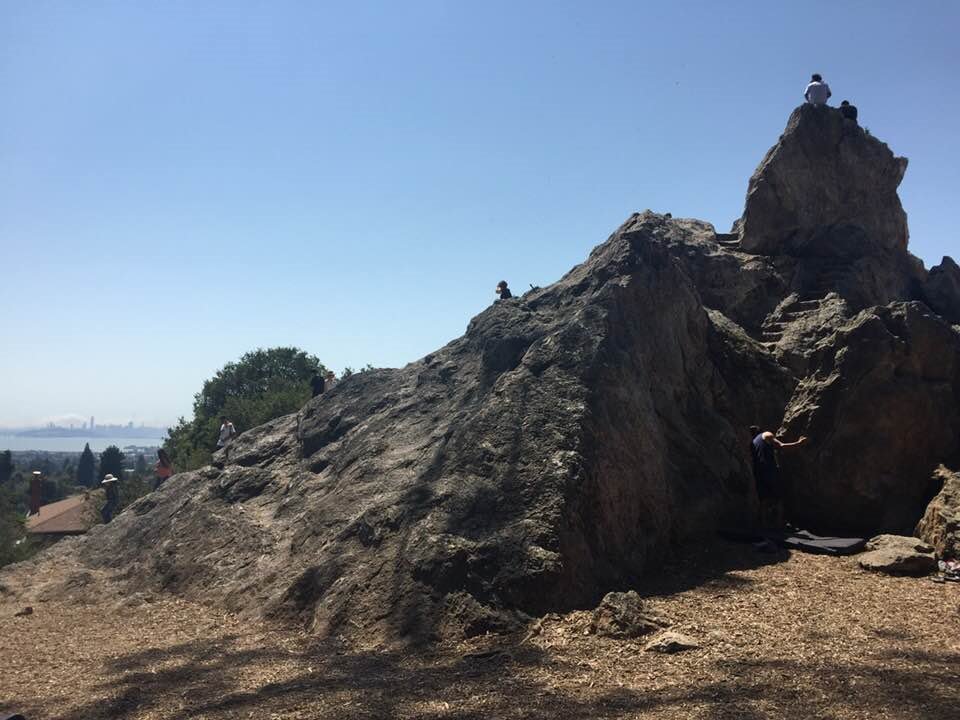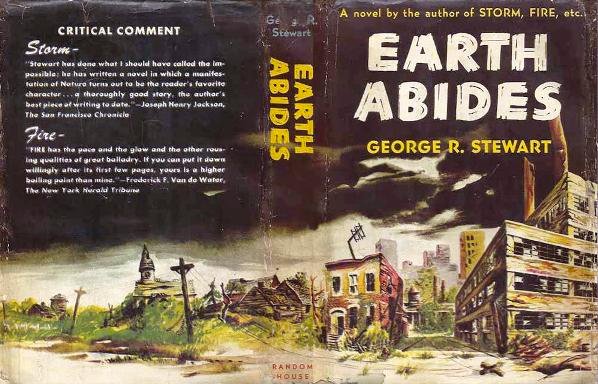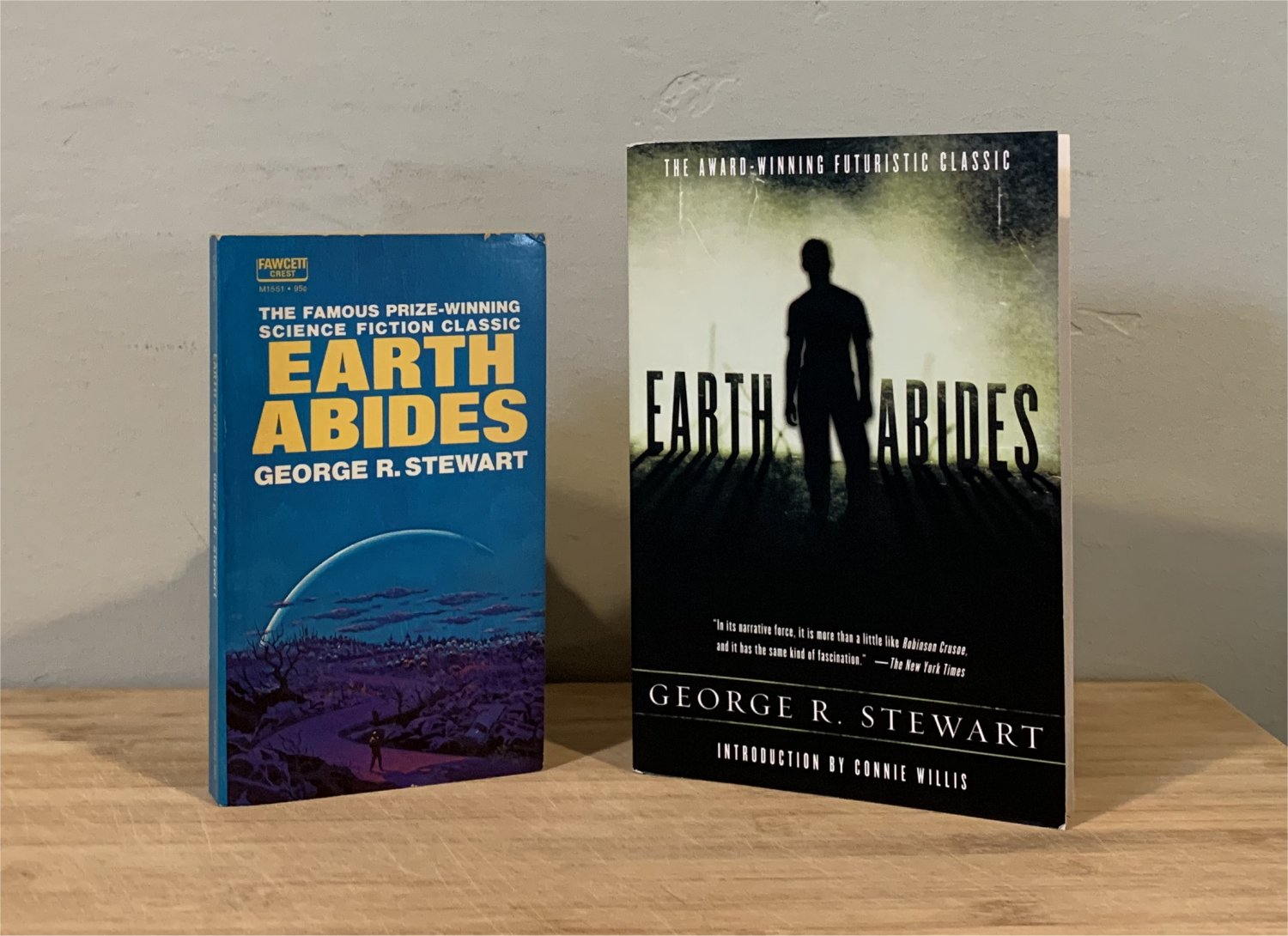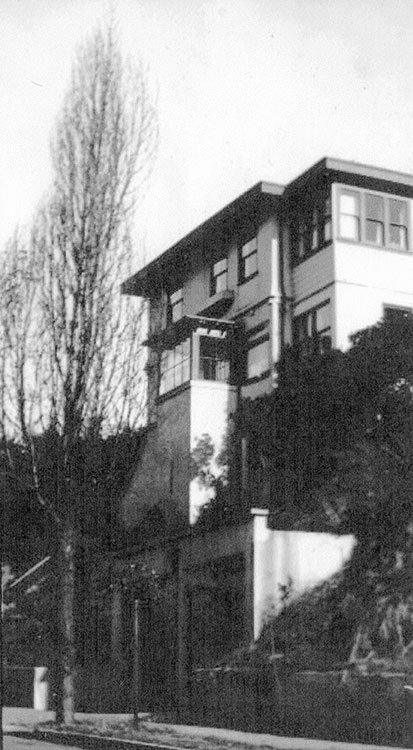Things Are As They Are: George R. Stewart’s Earth Abides
Cover by H. Lawrence Hoffman
Earth Abides (Random House, 373 pages, $3 in hardcover, 1949)
by George R. Stewart
Cover by H. Lawrence Hoffman
Here is one of the best science fiction novels of all time. It’s about the entire world, and implicitly the entire human race, and it’s as timely as ever as, for one reason or another, humanity faces the realization that its indefinite survival on planet Earth is not guaranteed.
The novel is Earth Abides by George R. Stewart. It was published in 1949 and was Stewart’s only SF novel (though he wrote a couple earlier novels about natural catastrophes, including one about a storm that inspired the US National Weather Service to give storms names). It won the first International Fantasy Award in a year preceding the advent of the Hugos. (Stewart never wrote any other science fiction, and this novel wasn’t published as science fiction, but was later embraced by genre critics, much as the famous novels by Huxley and Orwell were.)
Above is the cover of the first edition. And here are the two editions I’ve read, a 1971 Fawcett Crest paperback with a Paul Lehr cover, and the 2006 Del Rey trade paperback edition.
Earth Abides is about the aftermath of a worldwide plague that kills off virtually all of humanity, all but a tiny number of people who are naturally immune. We gather this number might be a dozen or two in any large city. It follows one particular character, Isherman Williams, Ish, as he returns to his city, which happens to be Berkeley, California, from a stay in the mountains, and discovers that the world seems deserted.
That is, the story begins after the initial catastrophe is mostly over, the part of it presumably involving mass panic and people dying in horrible ways. In this way it resembles similar stories, like John Wyndham’s The Day of the Triffids or the debut episode of The Twilight Zone, “Where Is Everybody?” (and numerous others I’m sure; there was a Martian Chronicle like this too), which invites the personal fantasy of having the entire world to one self, and the temptation of imagining what to do with it, despite the growing panic of not knowing how the world got this way.
The book then follows the rest of Ish’s life. And it does so in varying manners of scope and pace in a way that gives the novel a multi-dimensional impact.
Here’s a bulleted summary with comments indented one tab.
World Without End
In a 345-page book (I’m using the pagination of the 2006 Del Rey trade paperback edition), the first part, “World Without End,” is 127 pages. It follows Ish from day to day as he realizes what has happened and starts to make a new life for himself.
- He is living in the mountains, is struck by a rattlesnake, and lies in bed in his cabin recovering for the several days. (Perhaps that is what gives him immunity from the plague.)
- Recovered, he drives to town, finds no one; finds a week-old newspaper that tells of a disease sweeping the US, leaving 25-35% of the population already dead.
- He drives down the highway to the city, in the Bay Area, and to his parents’ home on San Lupo Drive.
- A Stewart website says the author’s actual house was on San Luis Road, in Berkeley; San Lupo is fictional, but the novel seems to base its house on the actual one. There’s a photo in the scroll at the bottom of the page, copied here:
- A lot of the older homes in the Oakland and Berkley hills are on narrow lots and so are tall, and/or deep. The location is about a mile north of the UC Berkeley campus.
- He walks the neighborhood, drives through town, finds only a handful of people, crazy or half-dead. He starts across the deserted Bay Bridge before deciding it’s pointless, and returns home.
- Ish is remarkably calm about all this, ready to be a spectator to observe what happens to the world in the absence of man. He considers his own qualifications: he has will to live; has always been solitary; did not experience the disaster firsthand. And is not superstitious.
- During these wanderings has passes through a park with tall rocks, that will become significant later.
- He packs his station wagon, befriends a dog, and drives cross country, over the Tehachapi Pass, across the Mojave Desert, into Arizona. He encounters an isolated family of timid Negroes. He eventually reaches New York.
- The city is empty. He meets a couple who hear his car approaching: Milt Abrams and Ann, two random survivors now living together, drinking warm martinis. Ish stays a night but finds them vacant, and departs.
- Soon he’s back home, gathering food from stores. The water still flows; a public library is nearby; the lights stay on… for a while, then fade.
- Weeks pass. He reads the Bible — Ecclesiastes, Solomon — pondering the meaning of life. And then he sees smoke from a chimney down the hill. And finds the house, and meets a woman there, Emma. After only a few minutes inside, they embrace.
- She moves in with him. They talk of having a child. Rat populations explode, and they worry about plague. Emma knows the time will come for her child… and reveals to him, very indirectly, her secret – that she’s half black. It doesn’t matter to him.
- Ish visits the university library, overwhelmed by its preservation of civilization. He decides to better keep track of time, and uses a surveyor’s transit to follow sunsets to the west across the bay. When sunset reaches furthest south and begins moving back north, that’s the solstice. He resolves to wait for the following solstice and then mark the end of Year One, somehow. Things aren’t finished; the world is without end.
Musings
Throughout the book are italicized passages that reveal what has happened outside of Ish’s experience — mostly about what is happening, or will happen, to the world at large, without humanity’s maintenance or interference.
The opening lines of the book are one of these passages, page 3: “…and the government of the United States of America is herewith suspended, except in the District of Columbia, as of the emergency. […] The West Oakland Hospitalization Center has been abandoned. Its functions, including burials at sea, are now concentrated at the Berkeley Center.” And so on.
Page 8: An encyclopedic passage about how populations of animals fluctuate, expanding until being struck by plague. Page 10: How a rodent on Christmas Island went extinct.
Then numerous passages about how the world as maintained by humans will deteriorate. About how pet dogs will die in their houses or merge with their wild counterparts. About how cats will die in their houses or not survive contact with wildcats. About grasses and flowers, gardens withering untended. What will happen to various livestock. Later, how the city decays, how cars will decay. In these we see how the Earth itself is as much a character in this novel as is Ish, as Connie Willis points out in her introduction to this edition. And these passages anticipate Alan Weisman’s striking 2007 book The World Without Us, which remorselessly describes how the artifacts of humanity will decay in days, years, and thousands of years after humanity’s hypothetical disappearance.
The farthest perspective is this from page 17:
High overhead, moon and planets and stars swung in their long smooth curves. They had no eyes, and they saw not; yet from the time when man’s fancy first formed within him, he has imagined that they looked down upon the earth.
And if so we may still imagine, and if they looked down upon the earth that night, what did they see?
Then we must say that they saw no change. Thought smoke from stacks and chimneys and campfire no longer rose to dim the atmosphere, yet still smoke rose from volcanoes and from forest fires. Seen even from the moon, the planet that night must have shown only with its accustomed splendor—no bright, no dimmer.
Quick Years
Stewart then shifts into fast forward mode to show what happens to Ish and Emma and others they meet, over the next 20 years, in 19 pages.
- At the end of the first year, at a small park near their house where tall rocks lean against each other, Ish chisels out the number 1, to mark the first year: the Year of the Baby.
- Personal aside: as I read this I had a frisson: could he be talking about Indian Rock Park? It was a place I had just visited, with my family, about six months before I reread this novel (which was about a year ago now). It’s a small park of enormous boulders now surrounded by homes in the Berkeley Hills; there are several similar parks in the area, presumably outcrops of rocks the home developers didn’t figure worth clearing. (Various websites devoted to George R. Stewart confirm this as the park described in the book.)
- Here’s my blogpost about the visit: www.facebook.com/Mark.R.Kelly/posts/10156013994243717. (Which I’ve made public.) And my photo; the San Francisco skyline is in the distance.

- And here’s the official website.
- Back to the book: The years pass, each one chiseled into the rock and given a name. The year of the garden; the year of the fires. Wildfires in northern California were as common then as now (it’s just that now they’re so much more destructive, since humans have been building further into fire-prone areas).
- A man, Ezra, visits them a while, departs, and returns two years later with two wives, a situation presented matter-of-factly. [This was an issue in Day of the Triffids too.] Another couple appears, and stays. They become a small tribe of seven adults, four children, and a half-wit, Evie.
- They deal with cattle, mountain lions. Ish tries conducting church, for the children’s’ sake; but Ish is a skeptic, and thinks of it as a sham, and ends it.
- An old man passing through brings them an epidemic, and three children die.
- Wood carving becomes a fad. In Year 16, the first children get married.
- In Year 17, a nearby house collapses. (Recall Alan Weisman. As a homeowner myself, I completely sympathize with the idea that, without regular, unending maintenance, a house might simply decay in a decade or two and fall down.)
- Year 20: a big earthquake, and more houses fall down.
- Year 21: One boy, Joey, who’s bright but no good at play, learns to read.
The Year 22
This middle section is the longest in the book, running from page 147 to page 304. Having employed three different narrative strategies, from the Stapledonian to the single point-of-view, Stewart now focuses on a single dramatic year in the lives of Ish and his kin.
The epigraph to this section, on page 147, concerns those Europeans who (in the early settlements of America) defected from their settlements to become Indians, while no Indians left their villages to settle with the Europeans. Exactly the same point was made in Sebastian Junger’s 2016 book Tribe to try to understand why “primitive” society is, to many, so much more attractive than “modern” society.
The events of this year:
- Ish ponders the future and thinks about who might someday lead their tribe. He focuses on Joey, the smart one.
- The water runs slow; they discover the reservoir is running low.
- Two boys fix up a jeep and leave on an expedition east.
- The tribe grows. Ish resumes teaching. He realizes the power of holding a hammer, which is regarded as a holy relic [ recall Lord of the Flies‘ conch! ]
- The two boys return, bringing an older but dirty man, Charlie. They’d reached Chicago. The tribe become suspicious of Charlie, a threat to their order, for various reasons, and vote to execute him. And they do.
- Another disease strikes, perhaps typhoid fever. Ish succumbs, but survives, and learns that – SPOILER, since this is the most emotional scene in the book – among others, Joey, his hope, has died.
- Ish spends weeks convalescing. He goes for a walk, considers disposing of the hammer, but does not. He walks to the campus, and in the library finds a book he once read about climate: “Climatic change was not a practical problem,” he thinks, and puts the book back.
- Ish becomes disconsolate. Perhaps Joey may not have been able to change anything. The Tribe won’t rebuild civilization. They will run out of supplies, or ammunition, or matches.
- He decides: no more school. Instead, he teaches them how to make bows and arrows. The children are fascinated and competitive. Ish takes solace in that they have an invention to fall back on when there are no more rifles.
- The year ends, and they simply name it, Year 22.
Musings
There are several in this section too, some of them thoughts about human society that might well be Ish’s:
- Page 190, how long the bridges will last.
- Page 210, how old boundaries, like fences, give way to landmarks.
- Page 219, education, from a child’s point of view: Civ-vil-eye-za-shun! That is what Uncle Ish talked about. There are lots of quail by the stream today. Two-and-six? I know that! Why should I say it to him? Two-and-nine? That is hard. It is more than my fingers. It is the same as “a lot.”
- Page 231, what happens to a culture when its promised one is gone. Between the plan and the fulfillment stands always the frail barrier of a human life.
- Page 233, Ish muses about being treated like a god, receiving sacrifices.
- Page 293, How people yearn to escape from daily life to go fishing, or camping, or sit in a cabin or on a beach. What a strange thing then is this great civilization, that no sooner have men attained it than they seek to flee from it! […] Why do the legends look back toward some golden day of simplicity? Must we not think then that this great civilization grew up, not by men’s desires, but rather by Forces and Pressures. Step by step, as villages grew larger, men must give up the free wandering life of berry picking and seed gathering and tie themselves to the security (and drudgery) of agriculture… Yes—this is the key.
Quick Years 2
A shorter, 10 page fast forward, taking Ish into old age.
- Adult members of the tribe die.
- In Year 34 they meet another group north of the bay and agree to merge, for the sake of wives.
- Em dies; Ish marries a young woman from the other tribe and has more children.
- In Year 43 Ish is too tired to carve the rock and given the year a name, and the tradition dies.
- A fire ravages the city for a week.
- Then Ezra dies, the last of the original tribe’s adults, and Ish realizes he is the last American.
The Last American
This final section is just 30 pages long.
- One day a young man, Jack, comes to Ish, showing off his bow and arrow. Rifles can’t be trusted. The boy shows his red and white arrows, with points made from different “corns” (i.e. coins) with pictures on them of the Old Ones, who perhaps made the hills and the Americans. Red arrows are for one kind of hunting, white for another. Why?, Ish asks. The boy replies that there is no why, things just are; “It is like the sun that keeps on going round the earth, but naturally no one knows why, or asks why. Why should there be a why?” Ish is tempted to respond, but stops himself. It doesn’t matter; superstitions will arise.
- Ish asks the boy, are you happy? Jack responds, “Yes, I am happy. Things are as they are, and I am part of them.”
- Then one morning there’s a fire and the entire group flees, Jack bringing the hammer. They huddle by the rocks as fire sweeps through the neighborhood. Now the second world is gone too, Ish thinks. They hike to the campus and camp there.
- In the morning they head west. Ish is weak, but clear-headed enough to realize he is dying. They go along the East Shore Highway, US 40 [now Interstate 80/580] and head out onto the bridge. Ish has a seizure, wakes to the boys appealing to him for some decision — about who should get the hammer. He indicates Jack. He sees the hills across the bay, and remembers the passage, “Men go and come, but earth abides.”
Musings
- Page 326: The cuts in the hills and the long embankments for the roads — they will still show as narrow valleys and ridges even after ten thousand years have passed. The great masses of concrete that were the dams—they will remain like the dikes of the granite itself. It goes on: three fires will destroy the rest: of rust, of decay, of flame.
- Page 331, sounding Biblical: Again, in that day each little tribe will live by itself and to itself and go its own way, and their differences will soon be more than they were even in the first days of Man, according to the accidents of survival and of place…
Notes and other quotes
- The main character, commentators note, is almost certainly named after Ishi, a Yahi Indian who emerged from the California mountains and into the modern world in 1911. His story was documented by the anthropologist Alfred Kroeber, father of Ursula K. Le Guin (who grew up in Berkeley).
- If a primary theme of the book is the almost welcoming of a return to a simple way of the life, the counterpart to that is the idea that knowledge, rationalism, escape from superstition (e.g. culminating in Ish’s atheism) are luxuries available only to individuals in a large civilization that can support them. Whereas in a tribalistic way of life, they are unneeded and perhaps counter-productive.
- P284.4: “Perhaps rationalism — like so much else — had only been one of the luxuries which men could afford under civilization.”
- P311.8: “Perhaps the brilliant ones were not suited to survive.”
- On the primary theme: commentaries like Wikipedia point out the reflection of Biblical themes in this novel – the recovery from the global catastrophe, etc. But I see both this novel, and the parables of Genesis, as reflecting the larger issue of the evolution of human culture, in particular the fallout of the transition from the hunter-gatherer way of life through the invention of agriculture to the sedentary way of life, some 10-12,000 years ago. Anthropologists and historians have increasingly recognized the inherent dilemma; Jared Diamond, in Guns, Germs, and Steel, called the Neolithic Revolution “the worst mistake in the history of the human race.” I wonder if perhaps the yearning for the simplicity of life before agriculture is what motivates not only the parables of Genesis, but the eternal notion that things were better in the “good old days” (an idea cited in “Death Sentence,” one of the Early Asimov stories!) all the way up to MAGA.
- And so this dilemma is surely as profound as any issue in literature: has the expansion of our species and our knowledge of ourselves and the universe through science and rationalism been worth it? Or is it better to be happy as part of a tribe and know nothing of the world? “Yes, I am happy. Things are as they are, and I am part of them.”
One quibble
The quibble is about Del Rey’s cover blub: “The Award-Winning Futuristic Classic.” There’s nothing futuristic about this novel; it’s set in the author’s present and was published in 1949, and the events in it could easily happen now as then.
Of course, this novel is science fiction because science fiction isn’t merely about speculative futures; science fiction is about the humanity’s place in and understanding of a presumably comprehensible universe that objectively exists independent of human desires and motivations. And in the balancing of its portrait of human nature as expressed in its characters and emerging new culture, with the depiction of a planet that is bound to endure whether humanity survives or not, Earth Abides addresses this broadest project of science fiction as well as any novel I know.
This article originally appeared at Views from Crestmont Drive.
Mark R. Kelly’s last review for us was The Early Asimov by Isaac Asimov. Mark wrote short fiction reviews for Locus Magazine from 1987 to 2001, and is the founder of the Locus Online website, for which he won a Hugo Award in 2002. He established the Science Fiction Awards Database at sfadb.com. He is a retired aerospace software engineer who’s lived almost his entire life in Southern California. Find more of his thoughts at Views from Crestmont Drive.



I really must get around to reading this novel. There is one listed on a local eCommerce site i frequent, at a very reasonable price, but I simply cannot bring myself to buy it due to cover are not being my cop of tea. It is the Black Swan Eduardo Paolozzi art edition. I suppose I will just have to Abide until I can find an Ace, Corgi or Fawcet edition
This was a hugely influential book for me. I can trace a straight line starting with EARTH ABIDES, to FARNHAMS FREEHOLD, to ALAS BABYLON and THE STAND to my own shot at an apocalyptic novel, SUMMER OF THE APOCALYPSE.